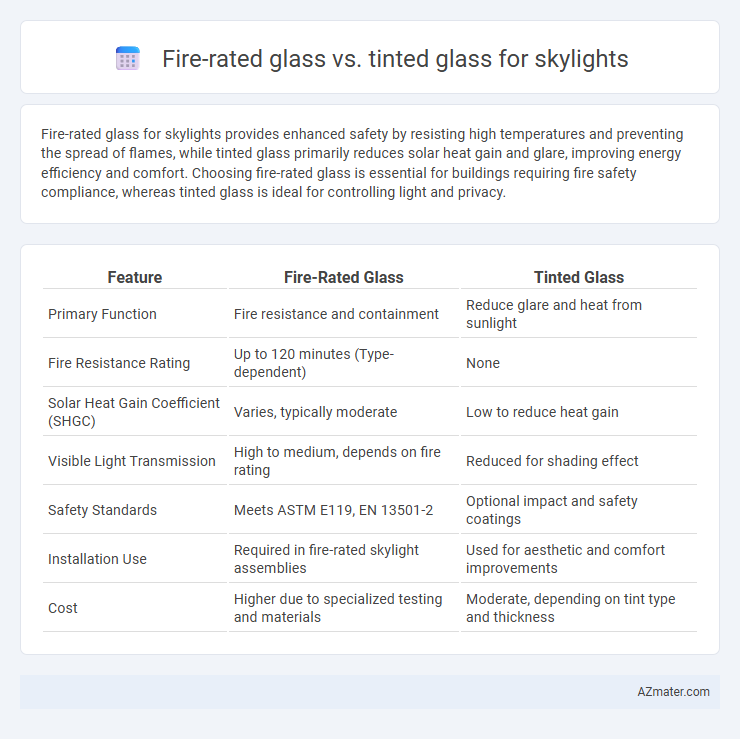Fire-rated glass for skylights provides enhanced safety by resisting high temperatures and preventing the spread of flames, while tinted glass primarily reduces solar heat gain and glare, improving energy efficiency and comfort. Choosing fire-rated glass is essential for buildings requiring fire safety compliance, whereas tinted glass is ideal for controlling light and privacy.
Table of Comparison
| Feature | Fire-Rated Glass | Tinted Glass |
|---|---|---|
| Primary Function | Fire resistance and containment | Reduce glare and heat from sunlight |
| Fire Resistance Rating | Up to 120 minutes (Type-dependent) | None |
| Solar Heat Gain Coefficient (SHGC) | Varies, typically moderate | Low to reduce heat gain |
| Visible Light Transmission | High to medium, depends on fire rating | Reduced for shading effect |
| Safety Standards | Meets ASTM E119, EN 13501-2 | Optional impact and safety coatings |
| Installation Use | Required in fire-rated skylight assemblies | Used for aesthetic and comfort improvements |
| Cost | Higher due to specialized testing and materials | Moderate, depending on tint type and thickness |
Introduction to Skylight Glass Options
Skylight glass options primarily include fire-rated glass and tinted glass, each serving distinct purposes for safety and energy efficiency. Fire-rated glass is designed to withstand high temperatures and prevent fire spread, making it essential for building codes in commercial and residential applications requiring enhanced fire protection. Tinted glass reduces solar heat gain and glare, improving indoor comfort and energy savings without compromising natural light transmission.
Understanding Fire-Rated Glass
Fire-rated glass for skylights offers crucial protection by resisting high temperatures and preventing the spread of flames during a fire, meeting specific building code requirements for fire safety. Unlike tinted glass, which primarily reduces solar heat gain and glare, fire-rated glass maintains structural integrity under fire exposure, ensuring occupant safety and property protection. Certified fire-rated glass typically contains special coatings or layers, such as intumescent materials, that activate in extreme heat to create a barrier against fire and smoke.
What is Tinted Glass?
Tinted glass for skylights is specially treated to reduce solar heat gain and glare by incorporating metal oxides or other colorants during manufacturing, enhancing energy efficiency and comfort. Unlike fire-rated glass, which is designed to resist high temperatures and prevent the spread of flames, tinted glass primarily provides shading and UV protection. This makes tinted glass ideal for controlling natural light and reducing cooling costs while maintaining aesthetic appeal.
Safety Standards for Skylight Glass
Fire-rated glass for skylights complies with rigorous safety standards such as UL 972 and NFPA 257, designed to withstand high temperatures and prevent the spread of flames and smoke during a fire. In contrast, tinted glass primarily serves to reduce solar glare and heat gain but lacks the structural integrity and fire resistance required by building codes for fire-rated applications. Meeting safety standards is critical for fire-rated glass to ensure occupant protection and property safety in skylight installations within commercial and residential buildings.
Fire Protection Capabilities: Fire-Rated vs Tinted Glass
Fire-rated glass for skylights is specifically engineered to withstand high temperatures and prevent the spread of flames and smoke during a fire, meeting strict safety standards like the NFPA 80 and UL 9 certifications. Tinted glass, while effective in reducing solar heat gain and glare, lacks fire-resistant properties and does not provide any significant protection against fire hazards. Choosing fire-rated glass ensures enhanced occupant safety and compliance with fire safety codes in commercial and residential buildings.
Energy Efficiency: Heat Control and UV Protection
Fire-rated glass for skylights offers superior heat resistance and UV protection by preventing the spread of flames and reducing radiant heat transfer, enhancing energy efficiency in buildings. Tinted glass primarily reduces solar heat gain and blocks UV rays by absorbing and reflecting sunlight, helping to maintain indoor temperatures and protect interior furnishings. Combining fire-rated glass with tinted coatings can optimize heat control and UV protection, resulting in improved energy savings and occupant safety.
Design and Aesthetic Considerations
Fire-rated glass for skylights offers a clear, no-tint appearance that maintains maximum natural light and visual openness, ideal for spaces where safety regulations are stringent. Tinted glass enhances aesthetic appeal by reducing glare and adding color tones, creating a distinctive ambiance while also offering energy efficiency benefits. Choosing between the two depends on prioritizing fire safety compliance with unobstructed views or achieving specific design moods and solar control.
Cost Comparison: Installation and Maintenance
Fire-rated glass for skylights typically incurs higher installation costs due to specialized materials and compliance with strict safety regulations, while tinted glass is generally more affordable and easier to install. Maintenance expenses for fire-rated glass may also be higher because of the need for periodic inspections and certifications to ensure fire safety standards are met, whereas tinted glass requires minimal upkeep beyond cleaning. Investing in fire-rated glass provides enhanced protection and regulatory compliance, justifying the increased initial and ongoing costs compared to tinted glass.
Applications and Suitability for Different Spaces
Fire-rated glass in skylights provides critical fire resistance, making it ideal for commercial buildings, stairwells, and high-risk areas requiring strict safety compliance. Tinted glass is suited for residential or office spaces where glare reduction, UV protection, and energy efficiency are priorities, enhancing comfort without the need for fire protection. Each type addresses specific needs: fire-rated glass ensures safety in fire-prone zones, while tinted glass optimizes light control and thermal performance in everyday environments.
Choosing the Right Glass for Your Skylight
Fire-rated glass for skylights ensures compliance with building safety codes by providing heat resistance and preventing the spread of flames during a fire, making it essential for high-risk or commercial buildings. Tinted glass enhances energy efficiency by reducing solar heat gain and glare, improving indoor comfort while protecting furniture and flooring from UV damage. Choosing the right skylight glass depends on priorities such as fire safety requirements, energy performance, and aesthetic preferences tailored to the building's function and location.

Infographic: Fire-rated glass vs Tinted glass for Skylight
 azmater.com
azmater.com